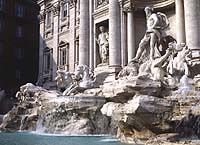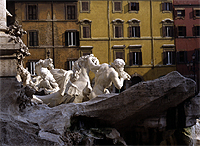Fontana di Trevi
Fontana di Trevi
 Late Baroque. The water fairly spurts and gushes - one could almost believe the larger-than-life sea horses are splashing through the waves, especially after dark with the spectacular lighting. It shows genius to create an enormous fountain in a small space.
Late Baroque. The water fairly spurts and gushes - one could almost believe the larger-than-life sea horses are splashing through the waves, especially after dark with the spectacular lighting. It shows genius to create an enormous fountain in a small space.
In the 1950's and 60's Rome became "Hollywood on the Tiber" and this fountain became the icon of pleasure-seeking in the Italian capital.
Fellini films, "La Dolce Vita", paparazzi, Anita Ekberg getting her body drenched and leaving little to the imagination.
 To ensure good luck and an early return to Rome, you must toss a coin over your left shoulder and into the fountain, (but in the old days one drank a glass of its sweet water for the same reason).
To ensure good luck and an early return to Rome, you must toss a coin over your left shoulder and into the fountain, (but in the old days one drank a glass of its sweet water for the same reason).
It has become a MUST to visit. And why not come when it is even more beautiful - at night?
The custom in Imperial times of building a monument where the new water arrived in Rome was copied by the later Popes, and some of Rome's fanciest fountains were created. These were called "Mostras" (Shows), and were also a commemoration for whichever Pope built them. The Trevi fountain is perhaps the showiest of the "Mostras".
The building behind was purposely left with a blank wall to accommodate the fountain. The figures are: Abundance on the left, Good Health on the right and, in the middle, the Ocean, Neptune, controlling the sea horses, with Tritons riding on their backs. Run, don't walk.
|
Fontana di Trevi
History 19 BC. With the help of a virgin, Roman technicians located a source of pure water only 14-miles/22 km from the city. This Aqua Virgo was piped over Rome's shortest aqueduct directly to the Baths of Agrippa. Rebuilt, it is now Acqua Vergine. 476 AD. Fall of the Roman Empire. Vandals, Visigoths, Goths, Huns all had their part in this. But the real "coup de grace" came 50 years later when a thoroughly demoralized Rome had its aqueducts broken by the Goths - stopping the fresh water supply. The Barbarians had finally figured out that by breaking the aqueducts, their siege would be over very soon, as Rome "sans" drinking water could not continue. Medieval. Popes did not realize how ingenious the Romans had been to have engineered a constant supply of fresh drinking water (the river was only used as a drain). It had taken the Ancients 800 years. 1453. Pope Nicholas V Parentucelli mended this aqueduct's tubes and built a simple basin to herald the water's arrival. 1629. Pope Urban VIII Barberini asked Bernini to do some drawings for it, but when the Pope died the project was abandoned. Bernini's lasting contribution was to move the fountain from the other side of the square to its present site - facing the Quirinal Palace (so the Pope could look down and enjoy it too). 1730-40. Competitions had become the rage during the Renaissance and Baroque periods to redesign buildings, fountains, and even the Spanish Steps. By the middle of the 18C two Popes had organized competitions for this monumental project - with no winners. Pope Clement XII Corsini organized yet another contest, which Salvi lost - but he was given the job anyway. 1751. Salvi died, with his work of art half-finished, but before he went he made sure a stubborn barber's unsightly sign would not spoil the ensemble. He hid it behind a sculpted vase. |
Palazzo Carpegna
Accademia di San Luca, inside Palazzo Carpegna, is an artists' association founded in 1577 by Muriano of Brescia and enlarged by Federico Zuccari, who added competitions with prizes, and teaching courses.
The academy was moved from it original location next to the Roman Forum when Mussolini built the "grande allée" Via dei Fori Imperiali.
The two houses of Cardinal Carpegna were destined to be converted by Borromini into a grandiose monument with an aerial walkway like Palazzo Colonna straddling the public road beneath, as permission to incorporate the road was denied to the future Pope. (His vote was to have been a shoe-in.). But he died just before his apotheosis.
The unreconstructed palace has a museum on the top floor, including paintings by Raphael, Guercino, Titian and Rubens, many gifts from the artist members.
Hours: Monday, Wednesday, Friday 10 am - 12,30 pm. Last Sunday of the month 10 am - 12,30 pm